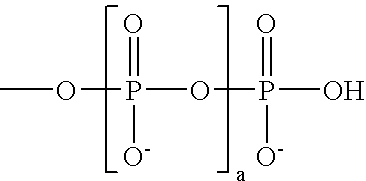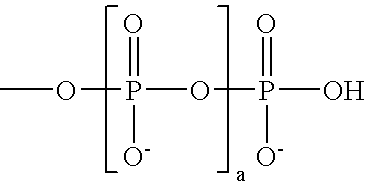Mobility-Modifying Cyanine Dyes
a technology of cyanine dyes and cyanine dyes, which is applied in the field of fluorescent cyanine dye compounds, can solve the problems of inability to rationally design such sets of "mobility matched" terminators, and no method exists to predictably alter electrophoretic mobilities
- Summary
- Abstract
- Description
- Claims
- Application Information
AI Technical Summary
Benefits of technology
Problems solved by technology
Method used
Image
Examples
Embodiment Construction
4.1 Abbreviations
The abbreviations used throughout the specification to refer to certain nucleobases, nucleosides and / or nucleotides are those commonly employed in the art and are as indicated below:
4.2 Definitions
As used herein, the following terms are intended to have the following meanings:
"Spectrally Resolvable:" means, in reference to a set of fluorescent dyes, that the fluorescence emission bands of the respective dyes are sufficiently distinct, i.e., sufficiently non-overlapping, that the dyes, either alone or when conjugated to other molecules or substances, are distinguishable from one another on the basis of their fluorescence signals using standard photodetection systems such as photodetectors employing a series of band pass filters and photomultiplier tubes, charged-coupled devices (CCD), spectrographs, etc., as exemplified by the systems described in U.S. Pat. Nos. 4,230,558 and 4,811,218 or in Wheeless et al., 1985, Flow Cytometry: Instrumentation and Data Analysis, pp...
PUM
| Property | Measurement | Unit |
|---|---|---|
| Time | aaaaa | aaaaa |
| Mobility | aaaaa | aaaaa |
Abstract
Description
Claims
Application Information
 Login to View More
Login to View More - R&D
- Intellectual Property
- Life Sciences
- Materials
- Tech Scout
- Unparalleled Data Quality
- Higher Quality Content
- 60% Fewer Hallucinations
Browse by: Latest US Patents, China's latest patents, Technical Efficacy Thesaurus, Application Domain, Technology Topic, Popular Technical Reports.
© 2025 PatSnap. All rights reserved.Legal|Privacy policy|Modern Slavery Act Transparency Statement|Sitemap|About US| Contact US: help@patsnap.com



